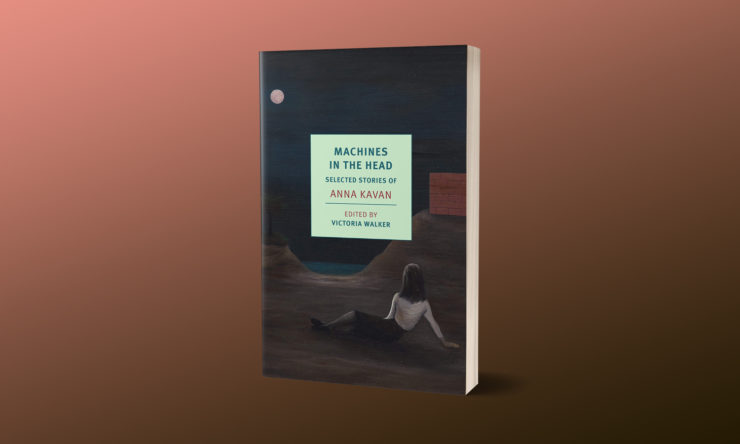She wrote Ice and then she died. She used prescription heroin for half of her life. She took the name she’s remembered by from one of her own early novels. If you’ve heard of Anna Kavan, and most likely you haven’t, chances are that these are the few things you know about her. Though she wrote more than a dozen novels and collections, though she was a journalist and a painter, Kavan is remembered for a single book and for the dramatic or disreputable portions of her biography.
This month, New York Review Books issues Machines in the Head, a volume of Kavan’s selected stories. It’s a slim book of weighty emotion that will leave readers perturbed. I admire it, but I can’t say I enjoyed it.
Though Kavan never, to my knowledge, counted herself as a science fiction author, Ice has influenced generations of sf writers; some consider it one of the first slipstream novels. Christopher Priest counts Ice among his essential books and contributes an introduction to the Peter Owen Classics edition; Jonathan Lethem, who occasionally practices science fiction and frequently writes slipstream, wrote the introduction to the Penguin Classics. China Miéville cites Kavan as an influence, and J.G. Ballard, Kavan’s fellow surveyor of externalized internal landscapes, also spoke highly of it.
Buy the Book


Machines in the Head
Machines in the Head is edited and introduced by Victoria Walker, a British academic and chair of the Anna Kavan Society. Walker does a fine job dispelling myths and putting Kavan’s work in its biographical, political, and social contexts, though she does occasionally indulge in special pleading, as when she observes that “critics have sometimes accused [Kavan] of writing only and obsessively about herself.” With the best intentions, Walker overemphasizes the political and social contexts of her Kavan’s fiction. So while any reader of stories like “The Blackout,” “Face of My People,” or the late “Julia and the Bazooka” will recognize the influence of the Second World War on Kavan’s fiction, the machines in her characters’ heads remain louder than the bombs outside. And if she was a self-dramatist, we must admit that her subject is interesting: Kavan led an unusually troubled and dramatic life.
The stories collected in Machines in the Head come from three collections published in Kavan’s life and from two published posthumously; a final story, “Starting My Career,” makes its debut here. Though Kavan’s style changes over the years — she occasionally incorporates collage effects, she dabbles in prose poetry, she introduces more explicit surrealism — the changes are not so dramatic as the introduction suggests. Twenty of the twenty-four stories have a first-person narrator; they’re typically of uncertain gender and are usually drugged, depressed, dissociated, or all three. Proper names are rare; when “Connecticut” and “New York” and “Grand Central Station” and “London” appear in the first paragraphs of “Ice Storm,” more than halfway through the book, it’s a shock. If there’s a single satisfied, much less a happy, person in these stories, I missed them. Though thirty-odd years separate the first stories in this collection from the last, there’s a claustrophobic unity throughout.
Kavan never grants her readers respite. Stories end in catastrophe or in impending doom; axes seem always to hang over the characters’ heads. Even the language unnerves. Sometimes she discomfits with odd, mannered syntax (“such effulgent lustre,” “grind elephantinely,” ); at other times with frenzy (A taxi accident: “Huge black clots, gouts of whale blood shoot high in the air, then splash down in the mounting flood, soaking the nearest pedestrians”). But perhaps her most familiar mode is complicated pain, simply expressed: “All I wanted then was for everything to go on as before, so that I could stay deeply asleep and be no more than a hole in space, not here or anywhere at all, for as long as possible, preferably for ever.”
Machines in the Head will interest readers of Ice, but anyone in search of a traditional science fiction collection, or even recognizable slipstream, will be disappointed. The early stories drawn from Asylum Piece feature obscure hierarchies of Patrons and Patronesses and advisers, it’s true, but any genre links are tenuous indeed. Some later stories are of greater genre interest. “Our City” overlays a bureaucratic structure out of Kafka atop a city resembling London during the Blitz; the strangeness is further heightened by the narrator’s bent analogies: “For who, even among the unprejudiced, would expect the city to show itself as an octopus?” “Five More Days to Countdown,” a posthumously published story of world war, an ersatz savior, and violent children, brought to mind the J.G. Ballard of Running Wild and War Fever. “A Bright Green Field,” to my mind the best story here, defies summation. Suffice it to say that the narrator’s recurrent visions of “a particular field” that “confronts” her wherever she might go — the specifics of the field’s size, color, and slope vary, but the field is somehow always the same — leads to a nightmare account of obscure, dangerous toil and culminates in a terrifying vision of lethal vitality, “a bright green pall beneath which all life would perish.”
I’m glad this book has been published and I’m glad I read it, but I don’t expect to push Machines in the Head on too many of my friends and acquaintances. Though the book comes in at under two hundred pages, it took me weeks to get through the stories; Kavan’s cranial machinery ground this reader to pieces, and when I put the book down, I hesitated to pick it up again. Whether you take this as an endorsement or as a warning is up to you.
Machines in the Head is available from NYRB Classics.
Matt Keeley reads too much and watches too many movies. You can find him on Twitter at @mattkeeley.










